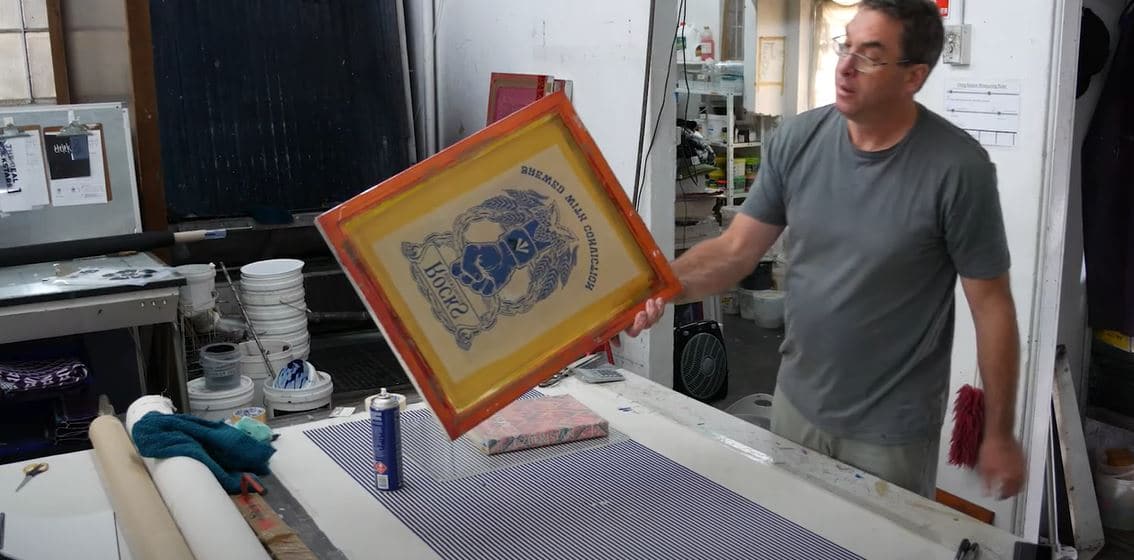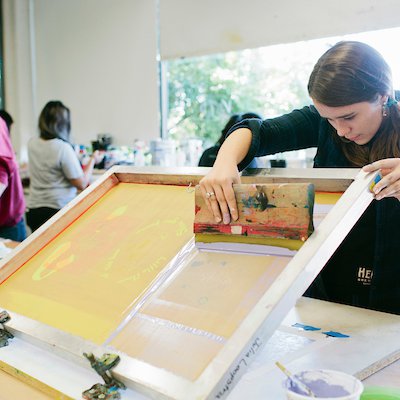ChatGPT said: 10:9 Design Embroidery success stories: how clients boosted their brand identity
Discover the Different Kinds Of Screen Printing Techniques for Your Following Project
Screen printing uses a varied variety of strategies that can improve any innovative project. From conventional techniques like serigraphy to modern technologies such as direct-to-garment printing, each method has its one-of-a-kind benefits. Specialized options, consisting of metal and green inks, introduce a lot more possibilities. Comprehending these strategies can considerably affect the last outcome. Nevertheless, the challenge lies in choosing the most suitable technique for certain requirements and preferred effects. What variables should one consider?

The Basics of Screen Printing
Screen printing might appear complicated, it is essentially an uncomplicated process that includes transferring ink through a mesh screen onto numerous surface areas. The method starts with the production of a pattern, which defines the design to be published. This stencil is connected to a mesh screen, commonly constructed from polyester or nylon. When the stencil remains in place, ink is applied to the screen and pressed with the mesh utilizing a squeegee, resulting in the wanted pattern being printed on the underlying material.
Screen printing can be executed on a variety of substratums, including paper, plastic, and textile, making it a versatile selection for various tasks. The process permits detailed designs and vivid shades, making it popular in sectors such as advertising and marketing, art, and fashion. Comprehending these basics outfits individuals with the foundational knowledge needed to explore advanced techniques in screen printing.
Typical Screen Printing Techniques
Standard screen printing methods have been used for centuries, preserving the craftsmanship and virtuosity of this approach. This technique uses a mesh screen to move ink onto a substratum, such as material or paper, allowing for resilient and dynamic layouts. The process starts with creating a stencil, which obstructs certain areas of the screen to control where the ink will certainly be applied.
One preferred technique is serigraphy, commonly used for limited versions and creative prints. An additional is the use of water-based inks, which are green and give a soft feel on textiles - 10:9 Design Texas. Additionally, conventional methods can include hand-operated printing, where artisans use ink with a squeegee, guaranteeing accuracy and attention to information
These strategies remain valued in the market for their tactile high quality and the distinct appearances they generate, attracting both designers and customers who appreciate the heritage of screen printing.
Digital Screen Printing Innovations
As the need for faster production and personalization in the printing market has actually surged, digital screen printing innovations have actually become a game-changer. This innovation blends conventional screen printing techniques with electronic procedures, permitting quick prototyping and elaborate designs that were formerly difficult to attain. One significant innovation is the intro of direct-to-garment (DTG) printing, which helps with premium, full-color prints on various fabrics without the requirement for displays. In addition, improvements in ink solutions have actually led to eco-friendly alternatives that preserve vivid colors while decreasing environmental influence. Using automated systems further simplifies manufacturing, minimizing labor costs and improving accuracy. These technologies not only accommodate small batch orders and tailored styles but also permit quicker turn-around times, making them optimal for organizations concentrated on conference client needs in a hectic market. Digital screen printing, subsequently, represents an important evolution in the domain name of printing strategies.
Specialty Screen Printing Techniques
Exploring specialty screen printing techniques exposes a diverse range of techniques that push the limits of imagination and capability in the printing sector. Amongst these, glow-in-the-dark inks provide a distinct aesthetic impact, making styles come active in low-light conditions. Metal inks, understood for their glittering finish, include a touch of deluxe to published materials. One more ingenious approach is discharge printing, which gets rid of color from the textile as opposed to adding ink, causing a soft, classic feeling. High-density printing creates a raised structure on the surface, boosting tactile involvement. Additionally, water-based inks are gaining appeal for their lively shades and minimized environmental influence. Each of these specialty methods caters to particular style needs, allowing brands and artists to produce standout products that reverberate with their target markets. By leveraging these techniques, businesses can boost their screen printing jobs to new elevations, guaranteeing unforgettable impressions.
Eco-Friendly Screen Printing Options
Eco-friendly screen printing options are getting grip as the sector shifts in the direction of sustainability. this contact form Sustainable ink selections and the usage of eco-friendly products are key elements in minimizing the environmental impact of the printing procedure. By taking on these methods, screen printers can add to a much more sustainable future while preserving top quality results.
Lasting Ink Choices

Biodegradable Products Use
As the screen printing industry advances, the incorporation of biodegradable materials is coming to be progressively crucial for environmentally conscious techniques. Makers and developers are currently exploring inks and substratums made from all-natural, renewable energies that decompose extra efficiently than standard counterparts. These eco-friendly alternatives decrease plastic waste and reduce environmental influence, straightening with the expanding need for lasting products.
Typical instances consist of water-based inks and organic cotton fabrics, both of which reduce harmful chemicals and promote eco-friendliness. Brands that take on these materials usually enhance their market charm, attracting customers that prioritize sustainability. As awareness of ecological issues remains to climb, the shift towards biodegradable products in screen printing is most likely to obtain momentum, fostering a greener industry criterion.
Picking the Right Strategy for Your Job
How can one figure out the most suitable screen printing strategy for a particular job? The decision pivots on numerous variables, consisting of the material to be published on, the intricacy of the style, and the desired manufacturing volume - 10:9 Design Abilene. For instance, direct-to-garment printing is optimal for intricate layouts with numerous shades, while standard screen printing excels for bigger runs of simpler graphics
In addition, consideration of the end-use of the published thing is necessary. For outdoor applications, strategies that provide durability and weather resistance, such as plastisol ink, might be liked. On the other hand, environmentally-conscious tasks might profit from naturally degradable materials or water-based inks.
Inevitably, recognizing the job's special requirements permits an educated selection, making sure both aesthetic charm and functional longevity. By evaluating design intricacy, product compatibility, and production scale, one can efficiently select the most suitable screen printing method to satisfy their project's goals.
Often Asked Inquiries
What Is the Background of Screen Printing?
Screen printing came from ancient China around 1000 ADVERTISEMENT, evolving with Visit Website Japan and Europe. By the 20th century, it came to be preferred in industrial art and fashion, revolutionizing how designs were created and dispersed globally.

Exactly how Do I Prepare Artwork for Screen Printing?
To prepare artwork for screen printing, one need to assure high resolution, make use of an appropriate shade setting, create different layers for each shade, and transform text to outlines, assuring compatibility with the printing procedure and preferred result.
What Products Are Ideal for Screen Printing?
The very best products for screen printing consist of high-quality inks, sturdy screens, and suitable substrates like cotton, polyester, or blends. In addition, utilizing appropriate emulsion and mops can enhance the printing process and outcomes.
Can I Evaluate Publish at Home?
Yes, screen printing in the house is possible. With the appropriate products, configuration, and methods, people can develop premium prints. Nevertheless, mindful consideration of office and tools is important for effective results.

What Prevail Mistakes in Screen Printing?
Common blunders in screen printing consist of improper exposure times, inadequate ink consistency, misalignment of screens, insufficient cleaning of products, and neglecting to evaluate prints. These mistakes can jeopardize the quality and precision of the end product.
Screen printing may appear facility, it is basically a simple process that involves moving ink via a mesh screen onto numerous surface areas. As the demand for faster production and customization in the printing market has actually surged, electronic screen browse around this site printing innovations have arised as a game-changer. Discovering specialized screen printing methods discloses a varied array of methods that push the limits of creativity and capability in the printing sector. The ideal products for screen printing include high-quality inks, durable displays, and suitable substratums like cotton, polyester, or blends (10:9 Design reviews). Typical errors in screen printing include improper exposure times, inadequate ink uniformity, imbalance of displays, insufficient cleaning of materials, and overlooking to examine prints